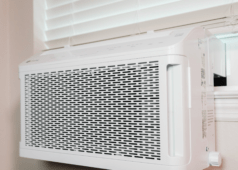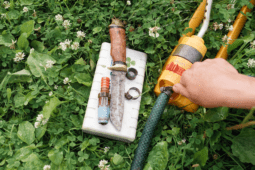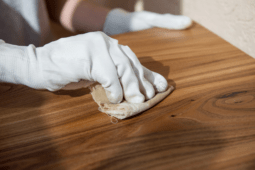How to: Make a Manly Gift Box
 Giving another man a gift is hard enough already, but then picking the right wrapping paper or gift bag is altogether impossible. Here’s a DIY project to hold that awesome gift instead.As Father’s Day approaches, I’m already thinking a bit about what to get my dad that doesn’t require a trip to the “As Seen on TV” store. The guy that actually made me into the person I am today deserves a bit better than another tie clip or remote caddy. With that in mind, I’m working up a box full of awesome that he’ll actually use, and decided I wanted to put said awesome into something better than a recycled shoebox covered in last years holiday paper.
Giving another man a gift is hard enough already, but then picking the right wrapping paper or gift bag is altogether impossible. Here’s a DIY project to hold that awesome gift instead.As Father’s Day approaches, I’m already thinking a bit about what to get my dad that doesn’t require a trip to the “As Seen on TV” store. The guy that actually made me into the person I am today deserves a bit better than another tie clip or remote caddy. With that in mind, I’m working up a box full of awesome that he’ll actually use, and decided I wanted to put said awesome into something better than a recycled shoebox covered in last years holiday paper. 
This manly, solid, re-useable crate was inspired by the guys over at ManCrates, who regularly pack small wooden crates with incredible items for very cool themed gifts. To make it a bit more challenging/interesting, I only used my table saw for the build.

*A Note on Safety – I’ve removed my guard for many of the cuts on this project due to visibility for pictures, and also because it was not always compatible with the types of cut I was performing. Always use every protection device on your equipment whenever possible including ear, eye and dust protection. There’s nothing you’re doing that’s more important than your fingertips (or worse!).
You’ll Need:
- (1) 1×4″ pine furring strip, 8ft long
- (2) 1/3″ pine furring strips, 8 ft long
- (1) 12″x12″ MDF/Plywood (for bottom of box)
- Total Wood Cost: $6.00
- Glue
- Clamps
- Table Saw
Cut List:
- (8) 1x3x7″ side pieces
- (8) 1x3x12″ side pieces
- (8) .25x5x7″ panel pieces (I cut these to final dimension after re-sawing in half – step 3)
Step 1:
Measure your Box – The first step is to figure out how large the box should be and dimension it properly. I decided I wanted to make a 12″x12″ cube, I wanted it to look weathered and industrial so I used very cheap rough pine.
Step 2:
Cut Pieces – The sides of the box are made like a panel door, with horizontal rails glued to vertical stiles and a center panel in a groove). I cut eight of the 12″ and eight of the 7″ pieces to size and set aside.

Step 3:
Re-saw for panel pieces – Re sawing on a table saw means to cut a piece in half on edge down the face to create matching boards out of single piece of wood. This is accomplished by setting the blade height to just over half of the total width of the board and cutting through the piece. After thr first cut, the piece is flipped end over end (keep the same face against the fence) and run through again. If the saw is set properly this should result in two matched pieces that are roughly the same thickness. Cut eight of these panels to the same length as the stiles (7″).

Step 4:
Groove It – Generally I would install a dado blade on the saw, or groove the pieces on the router table. But I wanted to stay rough and easy on this project so I cut the groove with the standard blade. I set the blade to a 1/4″ height and cut a groove down the edge. I made the groove wider than my 1/8″ blade by offsetting it to one side of the edge, then flipping the board face over face (opposite face to the fence on each cut) and cutting a second groove. This left a small amount of material in the middle of the piece that I went back and cut off with a third pass.

Step 5:
Notch the Rails – This step made for a better joint with more surface for glue. This step could have been fully skipped with very little impact on the appearance of the boxes, but probably doubled the joint strength overall. To notch the rails, I clamped a spacer block to my fence and used my miter attachment to make a shoulder cut. This first cut is the very furthest cut, I then ran the piece over the blade at 1/8″ increments to the end of the piece to make a nice notch that the mating piece would join to. This technique takes some practice to get smooth joints, but going slowly and taking the time to clean up any rough surfaces produces a nice cut.

Step 6:
Glue-Up – Once all pieces are cut to size, it’s time to glue them together. I added glue to all joints and clamped for a few hours, then after everything was dry I jointed all 4 panels into one box. While the glue was drying on that step, I measured and cut the bottom to size. This was glued and inserted in place and I let everything dry for about 6 hours. A note on the bottom – for strength, I should have cut a groove along the bottom face of each panel and inserted the bottom into this groove. This would have been a much stronger joint than the glued panel joint I ended up with.

Step 7:
Sand and Finish – I wanted to keep the general feel of the box rugged so I did a bit of sanding on edges and top and bottom, but overall kept the character of the wood intact. I plan to stencil a bit then add some color before filling the box with the father’s day bounty, so stay tuned for that post next week as we gather up and put together the gift for Father’s Day.









